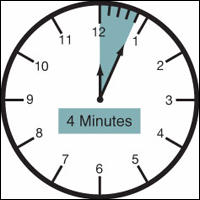Electric Power Generation, Transmission, and Distribution eTool
Medical Services and First Aid » 4-minute Rescue Requirement for Fixed Work Locations
§ 1910.269
In the proposed rule, OSHA requested additional information on the potential use of AEDs. See the proposed rule for additional information. (See proposed rule - "AED")
When an electric shock victim goes into cardiac arrest or ventricular fibrillation, it is important to call for emergency medical support (EMS) and start CPR within 4 minutes and continue CPR until rescue crews arrive. Brain damage and even death can occur if the blood flow is not reestablished within 4 minutes.
Field crews often work together, so CPR usually can begin within 4 minutes. But at fixed work locations such as power plants and substations, many people work alone. In these cases, OSHA requires that enough workers be trained in CPR and first aid and be positioned in such proximity to lone workers so that CPR and first aid providers are not more than 4 minutes from an electric shock victim. (See 1910.269(b)(1)(ii))
How Many CPR- and First Aid-Trained Workers Are Needed at Fixed Work Locations?

See:
1910.269(b)(1) and OSHA's February 22, 1999 Letter of Interpretation to Richard Terrill on 4-minute rescue requirements.
Employers need to evaluate their facilities to determine how many workers need to be trained so that at least one CPR- and first aid-trained person could arrive at any given location in the plant as soon as possible but within 4 minutes of discovery of an electric shock victim. If an employer cannot ensure that a trained worker can travel the distance necessary to reach a shock victim within 4 minutes – either because the number of workers is too limited or the size of the facility is too large – then all workers must be trained so hat assistance can begin as soon as the injury is discovered.
Many power plants have chosen to develop rescue teams that can address requirements for both 4-minute rescue and confined space rescue. Also, some team members receive Emergency Medical Technician (EMT) training and certification.
Medical Services and First Aid
- CPR training includes instruction on use of AEDs.
- Workers consider the use of available AEDs when EMS services are not readily available.

